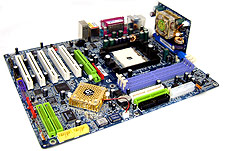The
Comanche 4 benchmark demo is a unique benchmark as it represents a real-world
gaming experience. It contains the single player "Eagle's Talon" mission from
the game as well as a detailed cinematic. This DirectX 8.1 benchmark demo will
measure your system's performance in the standard frames per second format. The
benchmark was run with audio disabled.
In Comanche
4, overclocking allows the Gigabyte motherboard to break 70 fps!
A
completely rewritten 3D engine based on DirectX8 encompasses many visual effects
such as volumetric Nebulae (gas clouds) that have a real impact in the game (you
can hide in them), many new engine, shield, weapon and explosion effects.
Objects cast real dynamic 3D shadows! Dynamic DP3 bump mapping allows a
previously unseen level of detail.
X2: The
Threat runs some nice numbers through the overclocked Gigabyte
K8NSNXP.
 Unreal Tournament
2003 Unreal Tournament
2003 |
Source: Epic |
|
Unreal
Tournament 2003 is the sequel to 1999's multiple 'Game of the Year' award
winner. It uses the very latest Unreal Engine technology - where graphics, sound
and game play are taken beyond the bleeding edge. Unreal Tournament 2003 employs
the use of Vertex as well as Pixel Shaders and it's recommended that you use a
DirectX 8 videocard to get the most out of the game.
If you're a
gamer you're going to like the frame rates the Gigabyte K8NSNXP pumps out at
stock speeds!
Conclusions:
When it was first introduce, many users were surprised to
discover that none of the initial Athlon64 chipsets included AGP/PCI locking. An
odd situation, since the AthlonXP and rival Pentium 4 systems both offered
this feature. If we consider that most early adopters of new technology are
enthusiasts, such shortcomings don't make much sense... but thankfully, nVidia
has righted the situation with the release of the nForce3-250gb
chipset.
 With the nForce 3 250
core logic, Athlon64 overclockers need not fear that their videocards, PCI
peripherals or HDD's will hold them back from pushing their hardware further.
And on the serious front, nVIDIA have also addressed several issues such as the
lack of native Serial ATA/RAID support, lack of Gigabit LAN, and the decreased
HyperTransport links of their previous core logic.
With the nForce 3 250
core logic, Athlon64 overclockers need not fear that their videocards, PCI
peripherals or HDD's will hold them back from pushing their hardware further.
And on the serious front, nVIDIA have also addressed several issues such as the
lack of native Serial ATA/RAID support, lack of Gigabit LAN, and the decreased
HyperTransport links of their previous core logic.
Gigabyte have done an excellent job with the GA-K8NSNXP
motherboard, primarily by including a long list of tempting features in it; IEEE
1394b, 7.1 audio, an additional Serial ATA RAID controller, IDE RAID, Gigabit
Ethernet, dual power supply, and of course their dual BIOS feature. And yes, the
Gigabyte GA-K8NSNXP includes all the necessary ports, cables and adapters that
you'll need to take advantage of everything we've just listed.
The performance of the socket 754 Athlon64 Gigabyte
GA-K8NSNXP motherboard was very good, as you have seen by the benchmarks, and in
terms of overclocking it was able to reach 234 MHz. Though, without
any multiplier controls, more dedicated enthusiasts will remain
unsatisfied. Irregardless, the Gigabyte GA-K8NSNXP is an extremely solid socket
754 Athlon64 motherboard for any main system. The only thing which precludes it
receiving an award is the fact that socket 939 Athlon64 boards are here, and
very tempting solutions if you can afford the price premium AMD has in
place...
Find out about this and many other reviews by joining
the Weekly PCstats.com Newsletter
today!
Related Articles
Here are a
few other articles that you might enjoy as well...
1. ABIT KV8-MAX3 Athlon64 Motherboard Review
